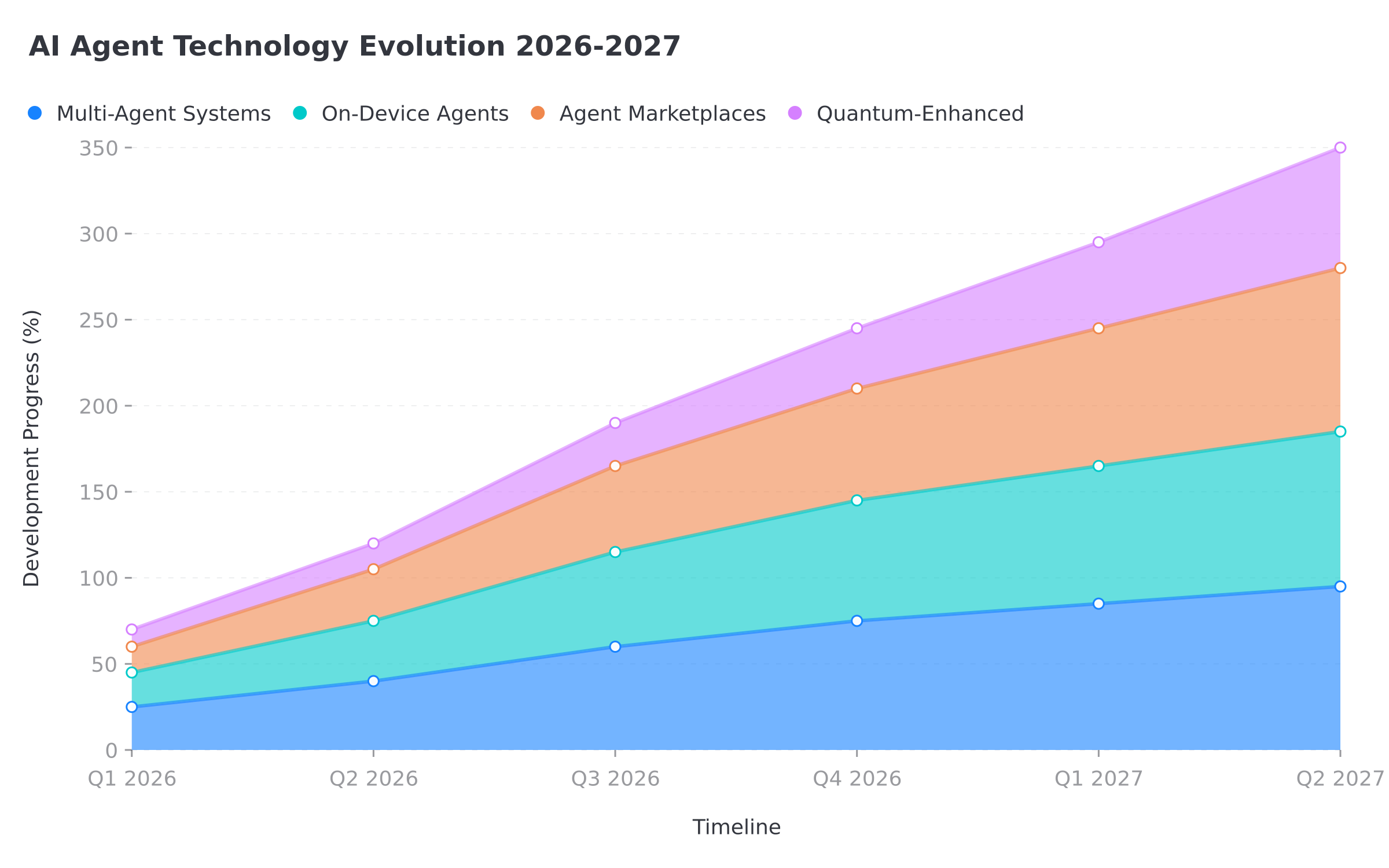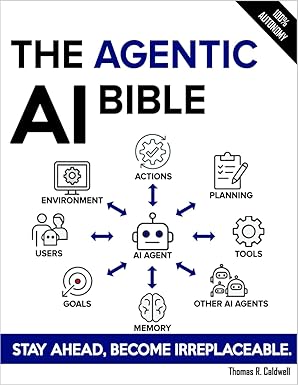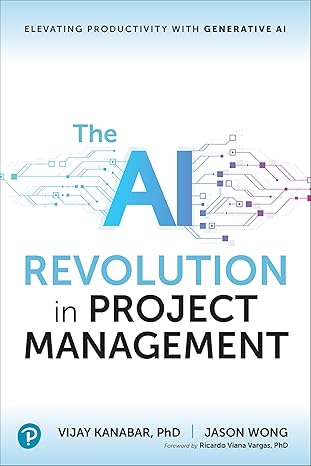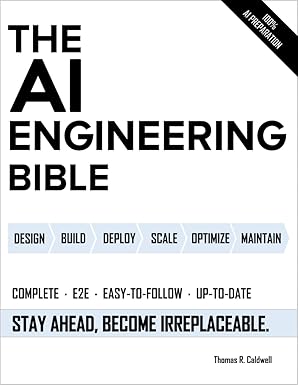On the Cusp of a New Wave: What's Next for AI Agents in 2026–2027

Ad Space
On the Cusp of a New Wave: What's Next for AI Agents in 2026–2027
The AI agent landscape is evolving at breakneck speed. While 2024-2025 established the foundation with tools like AutoGPT, LangChain, and commercial agent platforms, the next wave promises to be transformative. Here's what industry insiders, research papers, and early prototypes suggest is coming in 2026-2027.
Multi-Agent Collaboration: The Swarm Intelligence Revolution
Beyond Single-Agent Systems
The current paradigm of one agent, one task is giving way to sophisticated multi-agent orchestration. Think less "AI assistant" and more "AI team."
Key Developments to Watch:
1. Dynamic Role Assignment
- Agents that can negotiate and assign roles based on task requirements
- Real-time specialization where generalist agents become experts for specific subtasks
- Hierarchical structures that emerge organically rather than being pre-programmed
2. Consensus Mechanisms
- Voting systems where multiple agents validate each other's outputs
- Confidence-weighted decision making
- Automatic conflict resolution protocols
Example Architecture (Expected 2026):
class AgentSwarm:
def __init__(self):
self.agents = []
self.consensus_threshold = 0.7
def solve_complex_task(self, task):
# Decompose task into subtasks
subtasks = self.decompose(task)
# Assign agents based on capability matching
assignments = self.assign_roles(subtasks)
# Execute with cross-validation
results = []
for subtask, assigned_agents in assignments:
partial_results = [agent.execute(subtask)
for agent in assigned_agents]
consensus = self.reach_consensus(partial_results)
results.append(consensus)
return self.synthesize_results(results)
Leading Research Groups:
- DeepMind's Multi-Agent Research Lab: Working on emergent communication protocols
- OpenAI's Superalignment Team: Focusing on multi-agent safety and coordination
- Stanford HAI: Developing frameworks for human-multi-agent collaboration
Commercial Implementations Coming Soon
Microsoft's "Agent Mesh" (Expected Q3 2026):
- Integration with Microsoft 365 ecosystem
- Agents for different business functions (sales, marketing, operations) that collaborate automatically
- Built-in compliance and audit trails for enterprise use
Google's "Collaborative AI" (Expected Q1 2027):
- Multi-agent system integrated with Google Workspace
- Agents that can hand off tasks seamlessly (e.g., research agent → writing agent → review agent)
- Natural language coordination between agents
On-Device Agents: Privacy-First Intelligence
The Privacy Imperative
Growing concerns about data privacy and cloud dependency are driving a shift toward on-device AI agents. The breakthrough: models small enough to run locally while maintaining impressive capabilities.
Technical Breakthroughs Enabling This:
1. Model Compression Advances
- Quantization techniques reducing model size by 90% with minimal performance loss
- Pruning algorithms that maintain reasoning capabilities in smaller models
- Knowledge distillation creating specialized, compact agents
2. Edge Hardware Evolution
- Apple's M-series chips with dedicated neural engines
- Qualcomm's AI-optimized mobile processors
- NVIDIA's edge computing platforms
3. Federated Learning for Agents
- Agents that learn from local data without sending it to the cloud
- Collaborative improvement while maintaining privacy
- Personalization without centralized data collection
Real-World Applications (2026-2027)
Personal AI Assistants:
- Completely offline operation
- Deep integration with personal data (calendar, messages, documents)
- No data ever leaves your device
Enterprise Privacy Agents:
- Compliance-focused agents for regulated industries
- On-premises deployment for sensitive operations
- Air-gapped environments with full AI capabilities
Healthcare Agents:
- Patient data never leaves the hospital network
- Real-time analysis of medical records and imaging
- Personalized treatment recommendations with complete privacy
Under-the-Radar Projects to Watch
1. Mozilla's "Local AI" Initiative
- Open-source framework for privacy-preserving agents
- Browser-based agents that run entirely client-side
- Focus on user control and transparency
2. Signal's "Private Agent Protocol"
- End-to-end encrypted agent communications
- Zero-knowledge proof systems for agent verification
- Expected beta release Q2 2026
3. Brave's "Decentralized Agent Network"
- Blockchain-based agent coordination
- Tokenized agent services and capabilities
- Privacy-preserving agent marketplace
Agent Marketplaces: The App Store for AI Capabilities
The Modular Agent Economy
Just as mobile apps created an ecosystem of specialized tools, agent marketplaces will enable a modular approach to AI capabilities.
Core Concepts:
1. Skill Swapping
- Agents that can temporarily acquire new capabilities
- Rental model for expensive or specialized skills
- Dynamic capability loading based on task requirements
2. Agent Composition
- Mix-and-match approach to building custom agents
- Standardized interfaces for agent interoperability
- Version control and dependency management for agent skills
3. Reputation Systems
- Quality ratings for agent capabilities
- Performance metrics and reliability scores
- Community-driven validation of agent skills
Expected Marketplace Platforms
OpenAI's "Agent Store" (Rumored for Late 2026):
- Curated marketplace for GPT-based agents
- Revenue sharing with agent developers
- Enterprise-grade security and compliance
Hugging Face's "Agent Hub" (Expected Q1 2026):
- Open-source agent sharing platform
- Community-driven development and validation
- Integration with existing model repositories
Microsoft's "Copilot Marketplace" (Expected Q4 2026):
- Enterprise-focused agent capabilities
- Integration with Microsoft's business tools
- Professional services and support
Emerging Business Models
1. Capability-as-a-Service (CaaS)
- Pay-per-use for specialized agent skills
- Subscription models for frequently used capabilities
- Enterprise licensing for custom agent development
2. Agent Development Platforms
- No-code/low-code agent creation tools
- Template libraries for common use cases
- Automated testing and validation frameworks
3. Agent Performance Optimization
- Services that fine-tune agents for specific use cases
- Performance monitoring and optimization tools
- A/B testing frameworks for agent capabilities
Breakthrough Technologies on the Horizon
1. Neuromorphic Computing for Agents
What It Is: Computing architectures that mimic brain structure and function
Impact on Agents:
- Dramatically reduced power consumption
- Real-time learning and adaptation
- Better handling of uncertainty and ambiguity
Timeline: Early prototypes in 2026, commercial applications by 2027
Key Players:
- Intel's Loihi processors
- IBM's TrueNorth architecture
- BrainChip's Akida platform
2. Quantum-Enhanced Agent Reasoning
Applications:
- Optimization problems that are intractable for classical computers
- Pattern recognition in high-dimensional data
- Cryptographic applications for secure agent communication
Expected Breakthroughs:
- Hybrid quantum-classical agent architectures
- Quantum advantage in specific reasoning tasks
- Quantum-secured agent networks
Timeline: Research prototypes in 2026, limited commercial use by 2027
3. Biological-Digital Hybrid Agents
Concept: Agents that interface directly with biological systems
Applications:
- Medical diagnosis agents that analyze biological samples
- Agricultural agents that monitor plant health in real-time
- Environmental agents that interface with ecosystem sensors
Key Research Areas:
- Bio-compatible sensors and interfaces
- Real-time biological data processing
- Ethical frameworks for bio-digital integration
Open-Source Projects Flying Under the Radar
1. AutoGen (Microsoft Research)
What It Does: Framework for multi-agent conversations and collaboration
Why It Matters:
- Enables complex multi-agent workflows
- Strong community adoption
- Integration with popular AI frameworks
2026 Roadmap:
- Visual agent workflow designer
- Enterprise-grade security features
- Cloud-native deployment options
2. CrewAI
Focus: Role-based agent collaboration
Unique Features:
- Hierarchical agent structures
- Built-in task delegation
- Memory sharing between agents
Growth Trajectory:
- 300% GitHub star growth in 2024
- Major enterprise adoptions expected in 2026
- Integration with major cloud platforms
3. LangGraph
Purpose: Graph-based agent workflow orchestration
Innovation:
- Visual representation of agent interactions
- Conditional branching and loops
- State management across agent conversations
Future Plans:
- Real-time collaboration features
- Integration with agent marketplaces
- Advanced debugging and monitoring tools
4. Semantic Kernel (Microsoft)
Vision: Orchestration layer for AI agents and services
Key Features:
- Plugin architecture for extending agent capabilities
- Memory and context management
- Cross-platform compatibility
2026 Developments:
- Native multi-agent support
- Enhanced security and compliance features
- Integration with Microsoft's agent ecosystem
Industry Predictions and Timeline
2026: The Foundation Year
Q1 2026:
- First commercial multi-agent platforms launch
- On-device agents reach smartphone capabilities
- Initial agent marketplace platforms go live
Q2 2026:
- Major enterprise adoptions of multi-agent systems
- Privacy regulations specifically addressing AI agents
- First quantum-enhanced agent prototypes
Q3 2026:
- Agent interoperability standards established
- Significant improvements in on-device model performance
- First successful agent-to-agent autonomous transactions
Q4 2026:
- Multi-agent systems handling complex business processes
- Consumer devices with built-in agent capabilities
- Open-source agent frameworks reaching maturity
2027: The Acceleration Year
Q1 2027:
- Agent marketplaces with thousands of available capabilities
- Widespread adoption of privacy-preserving agents
- First neuromorphic agent implementations
Q2 2027:
- Multi-agent systems in critical infrastructure
- Agent-driven scientific discoveries
- Regulatory frameworks for agent accountability
Q3 2027:
- Quantum-classical hybrid agents in specialized applications
- Fully autonomous multi-agent business processes
- Agent-to-agent economy reaching significant scale
Q4 2027:
- Biological-digital hybrid agents in medical applications
- Agent swarms handling complex coordination tasks
- Foundation for next-generation AGI systems
Preparing for the Agent Revolution
For Businesses
1. Start Experimenting Now
- Pilot multi-agent systems for specific use cases
- Develop internal expertise in agent orchestration
- Create data strategies that support agent training
2. Privacy-First Approach
- Evaluate on-device agent capabilities
- Develop policies for agent data handling
- Consider regulatory implications early
3. Ecosystem Thinking
- Plan for agent interoperability
- Consider marketplace strategies
- Build partnerships with agent platform providers
For Developers
1. Learn Multi-Agent Frameworks
- Experiment with AutoGen, CrewAI, LangGraph
- Understand agent communication protocols
- Practice designing agent workflows
2. Focus on Specialization
- Develop expertise in specific agent capabilities
- Create reusable agent components
- Build reputation in agent communities
3. Stay Current with Research
- Follow key research labs and publications
- Participate in open-source projects
- Attend agent-focused conferences and workshops
Conclusion: The Agent-Native Future
The period from 2026-2027 will likely be remembered as the inflection point when AI agents moved from experimental tools to foundational infrastructure. The convergence of multi-agent collaboration, privacy-preserving on-device intelligence, and modular agent marketplaces will create entirely new categories of applications and business models.
The organizations and individuals who start preparing now—by experimenting with current tools, understanding the underlying technologies, and building relevant expertise—will be best positioned to capitalize on this transformation.
The future isn't just about having AI agents; it's about orchestrating them effectively, maintaining human agency and privacy, and creating value through intelligent collaboration between humans and artificial agents.
Want to stay ahead of the agent revolution? Start experimenting with multi-agent frameworks today, and keep an eye on the open-source projects mentioned above. The future of AI is collaborative, private, and modular—and it's arriving faster than most people realize.
Ad Space
Recommended Tools & Resources
* This section contains affiliate links. We may earn a commission when you purchase through these links at no additional cost to you.
📚 Featured AI Books
OpenAI API
AI PlatformAccess GPT-4 and other powerful AI models for your agent development.
LangChain Plus
FrameworkAdvanced framework for building applications with large language models.
Pinecone Vector Database
DatabaseHigh-performance vector database for AI applications and semantic search.
AI Agent Development Course
EducationComplete course on building production-ready AI agents from scratch.
💡 Pro Tip
Start with the free tiers of these tools to experiment, then upgrade as your AI agent projects grow. Most successful developers use a combination of 2-3 core tools rather than trying everything at once.
🚀 Join the AgentForge Community
Get weekly insights, tutorials, and the latest AI agent developments delivered to your inbox.
No spam, ever. Unsubscribe at any time.



